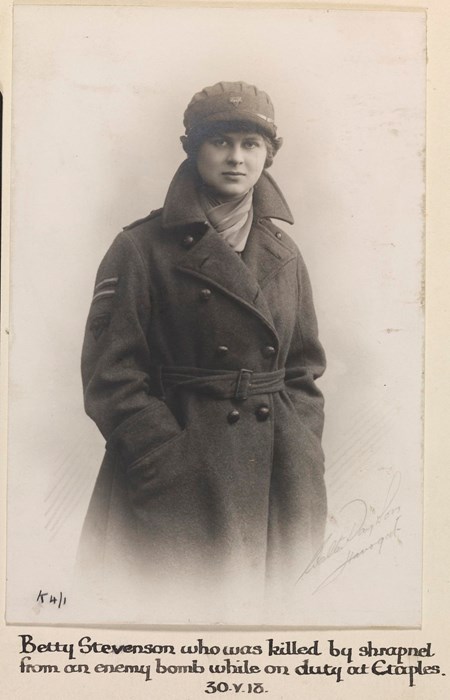
Betty was born on the 3rd September 1896 in Clifton in the Bootham area of York. She came from a well off middle class background and was educated at home until she was 14 whereby she was despatched to boarding school at St Georges Wood in Haslemere Surrey. From school she went to Brussels to study music. In 1913 the family moved to Harrogate where Betty’s father, Arthur, established himself as a leading estate agent. Betty had a younger brother born in 1901, James Arthur Radford, in which in her letters referred to him as JARS.
Both Betty’s parents were active supporters of the YMCA. Her mother Catherine served throughout the war as chair of the YMCA’s Women’s Auxiliary. Betty appears to have acquired early in her life a high sense of civic duty. Betty and her parents were part of the group that travelled to London to help with the Belgium Relief Fund after the outbreak of WW1. They would be involved in the transferring of refugee families to the Harrogate area from their encampment at Alexandra Palace.
In January 1916 one of Betty’s aunts went to France to manage a YMCA canteen and Betty was determined to join her. She set off on February 11th, aged 19, to join her in the St Denis Hut outside Paris. She completed her time at St Denis, took some home leave and returned to France to become a driver at Etaples in April 1917. Betty was extremely young at the time to be a driver, and her main duties involved transporting people to YMCA events such as lectures and convert parties, delivering stores, and taking relatives to visit their wounded family in hospitals and to attend funerals. Driving conditions at the time were exhausting, terrible roads, open topped vehicles in all weathers, and could be close to the front line.
The German spring offensive on 1918 had seen Etaples come under constant threat from air raids. During one such raid on the 30th May Betty was killed. She had been driving back from a train station with other workers and even though they had taken shelter under a bank a bomb would take her life. Betty was posthumously awarded the Croix de Guerre and is buried at the military cemetery in Etaples. She was just 21 years old.

Betty’s headstone at Etaples cemetery
Explore more memories from the ribbon
-
Albert Norris
265990 Private Albert Norris served in the Yorkshire Regiment, joining up sometime after January 1915. For his service during the First World War he was awarded the British War Medal and Victory Medal. He was transferred to the Royal Munster Fusiliers and served at the garrison in Cork. Following the war, he ran a Draper’s shop in Tonbridge, Kent. In 1924 He married Myra Donovan. Albert’s step granddaughter is Dame Kelly Holmes, double Olympic Champion.
-
Herbert Read DSO, MC
Herbert Read served in the 2nd, 7th and 10th battalions of the Yorkshire Regiment from 1915 to 1918. During his time in service he was awarded the Military Cross for his actions in leading a trench raid, successfully securing a German prisoner for interrogation and a Distinguished Service Order for his role commanding the 2nd Battalion during the German Spring Offensive of March 1918. He published two volumes of war poetry during the conflict and is commemorated alongside Wilfred Owen and Siegfried Sassoon in Poets’ Corner in Westminster Abbey. He became a leading figure in the 20th Century, as curator at the Victoria and Albert Museum and Professor of Art at Edinburgh and Harvard Universities. He counted Picasso, Dali, Graham Greene, George Orwell, Peggy Guggenheim and Man Ray amongst his friends. A knighthood in 1953 (at the suggestion of Winston Churchill) came as a surprise to his circle of political associates. His headstone at St Gregory’s Minster near Helmsley reads ‘Knight, Poet, Anarchist’.
-
2nd Lieutenant Arthur F Clarke
2nd Lieutenant Arthur F Clarke was attending the 5th Battalion annual camp in Wales when war broke out. He spent the first months of the war moving between Scarborough, Hull, Newcastle, Hartlepool and Darlington. On the 18th April 1915 he went out to France and was wounded during a gas attack on the 26th May 1915. The Green Howards Gazette records: “The day seemed interminable as the poor shelter had to be hugged tight all the time. With darkness came the order that we were to pass through GHQ lines and take up a front line position in Zouave Wood facing Hooge, where the main attack by the enemy had been made. That little strip of ground has since been the cockpit of our Western front. On our journey up another man was killed, and Lieutenant A F Clarke was wounded. That tour was destined to be the worst we had so far entered upon.” We know he returned to the front line as the Green Howard Gazette for January 1916 records that he was wounded. He rose to the rank of Captain in November 1916.
